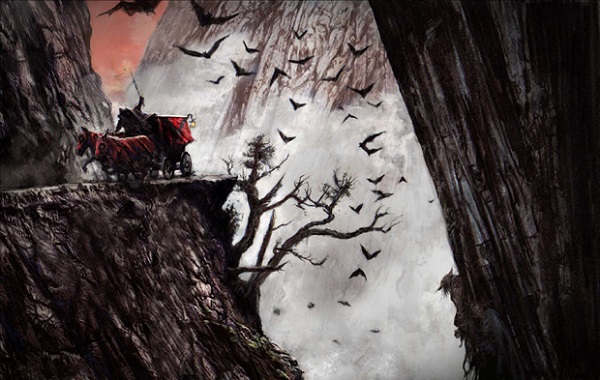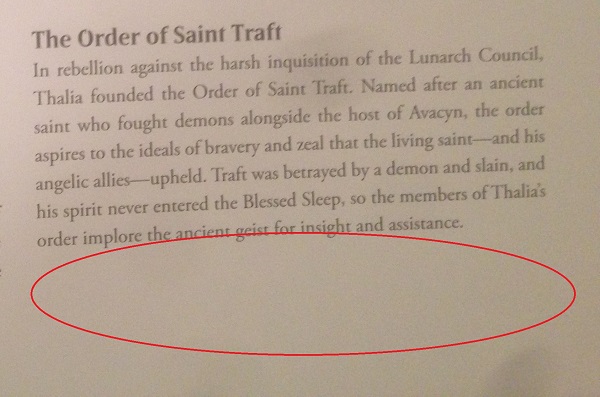Magic’s second art book has been released.
Since I’ve written about the first Magic Art Book of Zendikar not long ago, if you want to read that first, I figured this second go around I should bring some new information to the fold. The author himself, James Wyatt, has wonderfully agreed to a short little interview about the book. He is also sat opposite to Mark Winters on Access Magic episode three, if you want to hear more of James talking about Innistrad.
With that, let’s dive into that and then come back to chat.

Hello James and thanks for being available! To start things off, let’s ask what are your expectations for the book?
I expect that fans of Magic art and lore will love this book as much as they did the Zendikar book.
Who is your target audience for this book?
Everyone who loves Magic lore, fantasy art, and fantastic worlds.
Everyone, everywhere because obviously, who doesn’t love those things? You definitely have a strong writing voice of clarity. The book is very easily readable. What book or books have had a strong influence on you or your writing?
A couple of years ago, I did a Facebook meme that involved listing 10 books that left a lasting impression on me. Here’s my list:
- Lord of the Rings (Tolkien)
- On Being a Christian (Kueng)
- The Crucified God (Moltmann)
- Reading Like a Writer (Prose)
- Swords and Deviltry etc. (Leiber)
- The Heart of Christianity (Borg)
- AD&D Player's Handbook etc. (Gygax)
- High Fidelity (Hornby)
- Varieties of Mystical Experience (James)
- Scripting Jesus (White)
As a writer, the one I’d particularly call out is Reading Like a Writer by Francine Prose. It’s an exploration of what makes some classic writers great, from a writer’s perspective. I particularly credit it with giving me permission to unleash my inner poet (as my wife describes it) once in a while.
How do you find or make time to write?
My work schedule accommodates my work on these books. Although, in the case of Innistrad, the work I did on the world guide for Shadows over Innistrad/Eldritch Moon made the process of writing the art book much easier.
All of my novels, by contrast, were written on my own time — largely in the mornings before I went in to the office. I find that writing fiction feeds my spirit, in a way, so I make time for it when I don’t have time scheduled.
This is the second iteration, what were some of the big iterations you had after the first book?
You’re not going to see a lot of differences between the Zendikar book and the Innistrad one, except in terms of the content, of course. The biggest changes happened behind the scenes, as Dawn Murin (Senior Art Director) and I ironed out our process of selecting art and working with Viz to coordinate the layout. We went into the Zendikar book without a particularly clear idea of how the pages were going to look or how much art we needed, so once that book was done we had a much better idea of what we needed to do.

Crop taken of great new visual overlays in the art book
Many international artists are reading this, using this is a pseudo guide on "how to" make art to get into Wizards. Considering the amount of depth that went into world-building, what are some key themes about Innistrad you wrote about that impact and aid art creation?
I suspect that artists would be better served by talking to other artists who are working for us, or reading their accounts of how they got started working for us. The process of making art for Innistrad had a lot to do with capturing the tone — which for Innistrad is very easy to communicate, by pointing to classic Gothic horror — and then fine details like choosing a perspective that’s close in and often looking upward (in contrast to Zendikar’s sweeping landscapes, for example).
In fact, that’s kind of a funny difference between the two art books: They both have geography sections, but with Zendikar it was much easier to find gorgeous landscape art for each region than it was for Innistrad. So for Innistrad, the art in those sections is less about what the different provinces look like and more about what they feel like, if that makes sense.
Oh it makes sense.

Additionally, if you’re really looking into a “how to Magic cards” you should be buying up Ryan Pancoast’s Gumroad series. The Innistrad art book shows you the final product but now how it’s made. Ryan gave me a free preview to check it out and I’m delighted that he did. I couldn’t look away for that half hour.

Imagine Ryan was Bob Ross, except for Magic cards. His videos are absolutely captivating if you’re into how art is made. He talks about the prompt, the colors he uses, creating reference lighting by showing you, how he transfers the sketch and even difficulties in creating the piece. I cannot emphasize this enough. If you are an artist wanting to get into Magic, you should be buying everything Pancoast creates there. For $10, you can get a book from Amazon on being a fantasy artist or you can buy Ryan’s video, right here, and get his process that you get to download and watch again and again.

Ryan Pancoast, explaining his paint choices. Image courtesy Ryan Pancoast and Gumroad.com
Are there misconceptions that people have about your book? If so, explain.
I think the thing that surprises people the most is that this isn’t a behind-the-scenes look at concept art and the process of world building, except for the few pages of the appendix at the end. That’s what a lot of “The Art of ___” books are. But these books focus on the finished art, which is mostly seen in a tiny rectangle and really benefits from being shown at a larger size. And also, of course, on the details of the world that inform and underlie the art.
Will there be concept art in upcoming books?
Some, yes. For the most part, my intention is to keep any behind-the-scenes aspects — concept art and card images — to the appendices of the books, with the bulk of the book presented from an in-world perspective. But there are exceptions.
NICE! That’s stellar news.
Who or how do you decide on what art gets to be a two-page spread?
Dawn Murin (the books’ art director) and I go back and forth on that.
Step 1 is that I pick art I really like that’s topically relevant to the pages where the art will appear.
Step 2 is that Dawn checks to make sure it will scale up that large and still look awesome, and that the key parts of the art won’t fall in the gutter when the book is printed.
If it doesn’t work, Dawn might offer suggestions for replacements, or else I go looking for another piece that fits the bill.
Why is this called an art book when it's really a Style Guide? Moreover, it's actually a campaign setting without the rules. What's up with that?
I don’t think it’s right to call it a style guide. A style guide is an instruction manual for artists and writers, to be used as a resource for creating art and text. This book is all about the finished result.
It is definitely a setting book — I mean, literally, it describes the setting for a game. The fact that it could also be used as a resource for a different game is . . . not coincidental, given my professional history. After working on the Forgotten Realms, Eberron, and other D&D settings, I approached this project with a pretty clear idea in my head of how I wanted to present the information drawn from our style guides.
Great. I tried super hard to get this question added, it’s one I definitely was unsure if it was going to be answered! I’m happy to hear the nuance. In most trading card games, we aren’t often given access to see art. Explaining what Magic made has also been a good question. “A game’s setting book” is a perfect way to say it.
How do you reconcile flavor text with the style guide, as freelancers are writing flavor text after the fact? Is there a methodology or priority system you employ?
The creative team does a lot of review of creative text, with a lot of eyes on it as we select submissions and polish them until they show up on cards. Part of that process is making sure that the flavor text doesn’t contradict the other things we’ve said about the world, including what’s going in the art book.
Right right, adding another medium of things to keep track can be voluminous! Of past Magic sets (or planes) what would be one you would love to write?
Well, Innistrad would have been my first answer. And Zendikar my second. I’d love to do similar projects for Theros, Tarkir, Ravnica, Dominaria, . . . wow, pretty much any plane.
As long as we keep buying them! Amen to having more! Will you be doing book signings?
I am scheduled to appear at San Diego Comic Con and sign books, both in the Viz booth and in the Hasbro booth. I don’t have plans for other signings at this point.
Let’s hope you don’t get mobbed, but absolutely dangerous to let us know about it. I’ll let the masses know! Speaking of being in the public, would you ever sit on a panel at a GP to talk about the creation of the book?
I think something like that is more likely to happen at a show like PAX, as part of our other offerings.
Can you please give us an interesting fun fact about the book?
The Art of Magic: The Gathering — Innistrad includes approximately 280 pieces of art, drawn from a pool of well over 1,000 available pieces set on Innistrad.
Any last thoughts for our readers?
I’m grateful for the awesome work done on these books by our art director, Dawn Murin, and my editor at Viz, Joel Enos. Lots of other people put their efforts into making these books awesome, as you can see on the credits page. Thanks, everyone!
Thanks James for taking the time!
Some Additional Thoughts
Since this is Innistrad’s second visit the amount of information you’ll find to be doubled from what you’d expect from just current state of Innistrad. They can’t predict the future, showing the tournament staple in a few months you’re using to be on all the two-page spreads but I definitely can see instances of important Standard playable cards getting a little more art face time.
What’s still missing but coming:
Players really want to see concept art. It’s not as if Wizards is utterly against showing concept art from the style guide, far from it! It just has to fit the intention of the book.
I took a screenshot from a YouTube official video showing this transformation, explaining Emrakul’s influential transformations. It’s great for players to see it in a video, but in two, five or ten years, if we’ve gone back to Innistrad again, will that reference material live as easily on a deeply buried video or in a book? Both aren’t instantly accessible but reference is marquee to any research, especially for academics or game designers looking for citations of Lovecraftian influences hitting the gaming market. I just hope we see more graphs and explanations in concept work, like the back of clothing for cosplayers as an easy example.

Image screenshot obtain via video from Access Magic Episode 2
What is still missing from these books (that people really want)
Indexes!
I write every week. I have utterly so many reference materials on Magic from novels and comics to player’s guides and scribbles. You’ll notice that it’s written for the here and now, meaning as you read it, it unfurls the plane if you’re familiar. If you’re new to it, you’ll find some information in the front, and as the story progresses into adding Emrakul, details emerge.

For example, the section on devils doesn’t mention Ashmouth, where they come forth from on Innistrad. That section comes later. Though, if you’re referring back to this page, they don’t reference each other. “For information on Ashmouth, their spawning ground, see page 210.” A similar issue arises for the Order of St. Traft.

An index at the back and perhaps a glossary of terms would really help this book be a reference tome for years to come with really minimal amount of work added. It’s just another demographic of person who will utilize it, looking for answers or information quickly.
Conclusion
The newest art book is still worth your $25 dollars. Absolutely it is. It’s a wonderful read at worst, and a stellar addition to your coffee table that you’ll keep for months at best. It is still improving via iteration, which is to be expected. I’m happy they are still making them and I look forward to having more of the community see and appreciate the art blown up. The artists work so hard and they should be appreciated for their brilliance.
If you’re a little shy about ordering it straight, go to your local Barnes and Noble and page through it. There’s normally one copy that has removed shrinkwrap there. You can see if you want to dive into the depth. The section on how ghosts/geists changed sure is interesting to read.
Then, go buy it!
-Mike


























